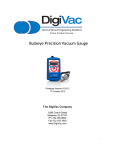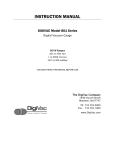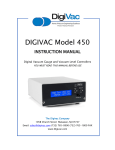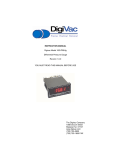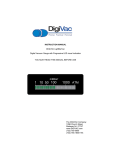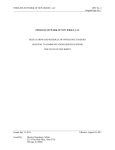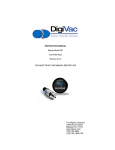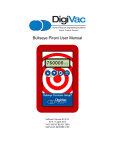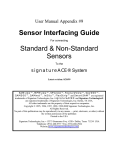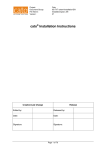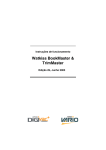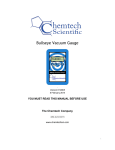Download Blower Bridle User Manual
Transcript
Blower Bridle User Manual Blower precision preservation control system Software Version K14E09 FCS 10 June 2014 The DigiVac Company 105B Church Street Matawan, NJ 07747 Ph: 732.765.0900 Fax:732.765.1800 www.DigiVac.com 1 Table of Contents Overview Modes of Display Display numeric Menu of Configuration Options Display Numeric format Precision Standard Scientific Setpoint value Units Calibration Version Set Point Operation Field Calibration Calibration parameters Calibration functions Functions F/ATM and F/VAC Functions F/LOAD and F/STORE UNDERSTANDING TORR SERVICING AND MAINTENANCE Maintenance FACTORY REPAIR AND CALIBRATION NOTES ON CALIBRATION Instrument Accuracy SPECIFICATIONS 2 Overview The blower controller utilizes a specially designed isolated vacuum transducer to achieve excellent accuracy and repeatability in industries where reliable automation is required. It incorporates an industry standard 0.54.5V voltage output with a waterproof connector. It is meant to be in a lights out operation where consistent control year in and year out is a must. Turn the device on, and it will read vacuum and enable a relay according to factory set points. Precise ● Accuracy available in 12 different measurement units ● Field calibratable ● Excellent repeatability over long periods of time Reliable ● Simple and easy to use ● Robust Design for lights out operation ● Isolated sensor that is immune to dirty processes any process compatible with 316ss. ● Water resistant NEMA4 enclosure and IP66 rated sensor with waterproof feed throughs Features: ● Line AC powered ● Always On ● Sensor present indication ● Smart bootup Delay in setpoint operation to avoid atmospheric blower on ● Field calibratable 3 Modes of Display The main screen of the blower bridle has a large screen for display and 5 LED to indicate relay status: ● Vacuum level ● Indication of measurement units ● “Blower on” or “Blower off indication (which ties to relay 1) ● LED indications for relays. Green means the relay is active, Red means inactive Controller has two display modes: Numeric and Cal. The numeric display has three numeric formats: standard, precision, and scientific. Display modes are selected from the Configuration option “Display”, and numeric formats are selected from the Configuration option “Numeric”. The SEL button enters and traverses the Configuration menu. Display numeric The following example shows the numeric display with the “precision” format. The following image shows the numeric display with the “scientific” format. 4 The numeric display shows the currently configured units, in these examples the vacuum pressure units are “microns” or “torr”. Below the units indicator are the battery, vacuum pressure, and vacuum system analysis indicators. In any display mode, the UP and DOWN buttons turn the backlight on and off (respectively), and the SEL button enters the configuration menu. The following example shows the numeric display when the vacuum sensor tube is disconnected or has failed. 5 Menu of Configuration Options Display Pressing the SEL button from the vacuum display screen will present the configuration menu. The configuration menu is a linear series of menu screens that are stepped or skipped through using the SEL button. Above each button is a utility hint to indicate button functions. The SKIP hint is above the SEL button to indicate that the SEL button is used to step or skip to the next menu screen with no configuration change. The ENTER hint above the ENT button indicates that this button is used to enter the display mode as shown in the menu screen. Using the UP or DOWN buttons will change the option available on the menu screen. In the example above, the configuration menu is ready to change the display to the Pumpdown Graph. In this state pressing the ENTER button will change the display to the Pumpdown Graph, or pressing the SKIP button will ignore the state of the menu screen and leave the display mode unchanged. Numeric format The numeric configuration option defines the vacuum pressure number format throughout all modes of display. The UP and DOWN buttons select a format type from “precision”, “scientific” and “standard”, and the ENT button saves the current choice. Precision 6 The precision format has three digits precision and micron accuracy. For example, an internal vacuum value of 1234 microns (µm Hg) would be displayed as 1.23 torr in the Precision numeric format with torr units. Standard The standard format has two digits precision and micron accuracy. For example, an internal vacuum value of 1234 microns (µm Hg) would be displayed as 1.2 torr in the Standard numeric format with torr units. Scientific The scientific format has two digits precision with a base ten exponent following conventional usage. For example, an internal vacuum value of 1234 microns (µm Hg) would be displayed as 1.2 x 100 torr. Setpoint value The Set Point Value is defined by 2 setpoints: upper and lower The lower setpoint is where the relay activates. The upper set point is where the relay releases. If the lower setpoint = the upper setpoint, the relay will turn on and off at a specific value with no hysteresis. Units The units configuration option permits numeric vacuum values to be displayed in any one of a 11 available vacuum pressure units including microns, Handheld, millimeters of mercury, Torr, mbar, Bar, Pa, kPa, inches of mercury, inches of water and PSIA. Note that inches of mercury and inches of water is zero referenced to 760 Torr absolute pressure. A negative number indicates vacuum, a positive number indicates pressure relative to sea level. Calibration This display option may enter the field calibration mode. Refer to the section “Field Calibration” for a complete description of the operation of the 7 Calibration function. Version The last step in the configuration menu reports the software version identifier. This software version identifier is useful for communicating with the factory or distributor support. 8 Set Point Operation The set point connections are situated in the upper right corner of the controller when looking at the display upright. There are 1 sets of pins: 1. N.C. – Normally closed. This means that above the setpoint value there is a current path between the common and the N.C. terminal. Put another way the switch is “ON” between these 2 terminals. At the set point value and below (higher vacuum, lower pressure) the connection is open. Put another way, the switch is “OFF” between the common and the N.C. connection at higher vacuum (a lower vacuum reading). 2. N.O. – Normally open. This means that above the setpoint value there is no current path between the common and N.O. connection. Put another way the switch is “OFF” between these 2 terminals. When the vacuum indication goes below the setpoint value (higher vacuum, lower pressure) the current path closes. Put another way the switch is “ON” between the N.C. and N.O. connections at absolute vacuum readings below the setpoint value. 3. common – The common line of a switch Take care in ensuring that the wire connections are made fast, and the voltage and current does not exceed 250V or 7A. If you need to control a device that draws more power, consider another relay in between the control output and the device to be controlled 9 Field Calibration From the Configuration option “Calibration”, pictured below, press the ENT button to enter the field calibration mode. The field calibration mode, shown below, shows digital signal counts and torr pressure times 10,000 (“Torr x 10+4”). For example, one micron (or millitorr) is “10” in the “Torr x 10+4” scale. Calibration parameters The calibration method employs a “zero and span” model. The “ATM” parameter is modified to align to 760 Torr, and the “VAC” parameter is modified to align to 5 Torr. In the “Torr x 10+4” scale employed in the Calibration mode, these pressures are represented with the figures 5000000 and 50000, respectively. Calibration functions The Calibration mode operates using a function concept. The current function is one of four available functions (operations) and is shown above the EXIT button hint as “F/LOAD” in this example. The four functions are F/LOAD, F/STORE, F/ATM, and F/VAC. The SEL button changes the current function among these four possibilities. Functions F/ATM and F/VAC The F/ATM and F/VAC functions enable the UP and DOWN buttons to change these parameter values. As these parameter values change, the internal pressure value register shown in the Calibration display (at “Torr x 10+4”) is modified. These values are not saved for use beyond the calibration session until they are stored using F/STORE. Functions F/LOAD and F/STORE The F/LOAD and F/STORE functions read and write parameters from and to persistent memory (long term storage). One of these two functions is available when the function indicator above the EXIT hint shows F/LOAD or F/STORE. In this case, pressing and releasing the UP and DOWN buttons together will execute the function. When the function has been successfully executed the display will flash, and an audible beep will sound (with the tone configured in “Sound Cal”). Completing a calibration session requires execution of F/STORE in order to save the parameters to persistent memory before exiting the calibration session. Exiting a calibration 10 session without successfully executing the F/STORE function will discard the calibration parameters. 11 UNDERSTANDING TORR The DIGIVAC and many similar instruments are calibrated in microns or "milliTorr." It is appropriate to discuss what microns are and to relate microns to other measures of pressure and vacuum. Microns are not really a measure of vacuum at all, but rather of absolute pressure. It will be recalled that the pressure of the atmosphere is 14.696 or approximately 14.7 pounds per square inch at sea level. This pressure is due to the weight of all of the air in the earth's atmosphere above any particular square inch. This 14.696 psi is equivalent to the pressure produced by a mercury column of approximately 29.92 inches high or .76 meters (about 3/4 of a yard) or 760 millimeters of mercury. Atmospheric pressure varies greatly with altitude. It decreases approximately 1 inch of mercury per thousand feet of altitude. It also varies widely with local weather conditions. (Variations of one half inch in a single day are common.) The word vacuum means pressure lower than atmospheric or "suction," but, in describing negative pressure, the atmosphere is only a satisfactory reference if we are dealing with values of vacuum down to about 27 inches of mercury. Below that, it is much more useful to talk in terms of absolute pressure, starting from absolute zero. The 801 and all similar instruments do just this. One TORR, a commonly used unit, is an absolute pressure of one millimeter of mercury. A milliTorr is equal to one thousandth of a TORR. A MICRON is the same as a milliTorr. 12 SERVICING AND MAINTENANCE Maintenance Your vacuum instrument should give you many years of trouble free service. There are no regularly scheduled maintenance intervals. If consistent accuracy is required, it is recommended that the gauge, tube, cable and power supply be returned for a yearly calibration check. FACTORY REPAIR AND CALIBRATION The vacuum gauge assembly is designed to provide years of troublefree service, and the liberal internal use of plugin components make it easily repairable. No field servicing of the unit is recommended, other than replacement of the sensor, but factory servicing and calibration are available at a nominal cost and fast turnaround times. NOTES ON CALIBRATION The controller reads in absolute units such as Torr, the reading of which moves opposite that of vacuum. Thus, a lower numerical reading actually is a higher level of vacuum. For more information, refer to section 8.0. Instrument Accuracy 1 to 760 Torr +/ 2 Torr SPECIFICATIONS Input Voltage 110VAC Maintenance Interval 110 years depending on use Overall Dimensions 3.45 in high, 7.4 in wide, 1.41 inches deep Mounting Screw center to center 6.937 in Ambient Operating range 0°C to 70°C 13 Measurement Media Fluid or Air compatible with 316 SS Certifications, controller display CE Planned 14














